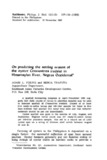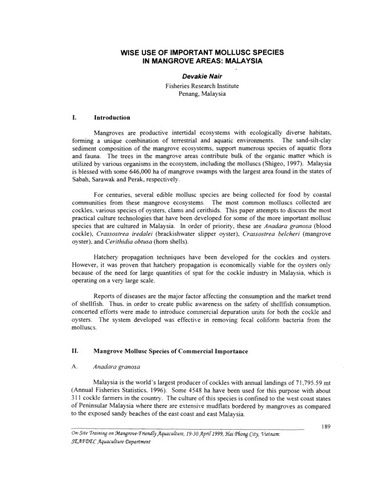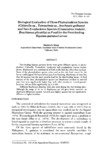On predicting the setting season of the oyster Crassostrea iredalei in Himamaylan River, Negros Occidental
- Global styles
- MLA
- Vancouver
- Elsevier - Harvard
- APA
- Help

View/
Date
1983Page views
2,040ASFA keyword
AGROVOC keyword
Taxonomic term
Metadata
Show full item record
Share
Abstract
A spatfall forecasting program in April-November 1981 suggests that daily counts of larvae in plankton samples may be used to forecast spatfall of C. iredalei . Counts of at least five ready-to-settle larvae per 100-liter sample for three to five days indicate that spatfall will occur very soon and that collector materials should be put out immediately.
Oyster spatfall was good in the months of July, August, and September. Highest larval count was 247 ready-to-settle larvae per 100-liter plankton sample; this led to a record set of 2,423 oyster spat on a string of thirteen shell cultch between August 24 and 31.
Description
Contribution No. 121.
Suggested Citation
Young, A. L., & Traviña, R. (1983). On predicting the setting season of the oyster Crassostrea iredalei in Himamaylan River, Negros Occidental. Kalikasan, The Journal of Philippine Biology , 12(1-2), 107-114. http://hdl.handle.net/10862/1145
Type
ArticleISSN
0115-0553Collections
- Journal Articles [1258]
Related items
Showing items related by title, author, creator and subject.
-
Wise use of important mollusc species in mangrove areas: Malaysia
Nair, Devakie (Aquaculture Department, Southeast Asian Fisheries Development Center, 2000)For centuries, several edible mollusc species are being collected for food by coastal communities from these mangrove ecosystems. The most common molluscs collected are cockles, various species of oysters, clams and ... -
Biological evaluation of three phytoplankton species (Chlorella sp., Tetraselmis sp., Isochrysis galbana) and two zooplankton species (Crassostrea iredalei, Brachionus plicatilis) as food for the first-feeding Siganus guttatus larvae
Duray, Marietta N. (University of San Carlos, 1986)First-feeding Siganus guttatus larvae were given different species of phytoplankton (Chlorella, Tetraselmis, Isochrysis) and zooplankton (oyster trochophores, Brachionus) or a combination of both on the first day when they ... -
A method of culturing/ growing high-quality edible oysters (Crassostrea spp. and Magallana bilineata)
Lebata-Ramos, Ma. Junemie Hazel; Southeast Asian Fisheries Development Center/Aquaculture Department (Intellectual Property Office of the Philippines, 2024-11-18)This utility model discloses a process of culturing/ growing high-quality edible oysters (Crassostrea spp. and Magallana bilineata) comprising the steps: selecting grow-out culture sites, deploying substrates ...





